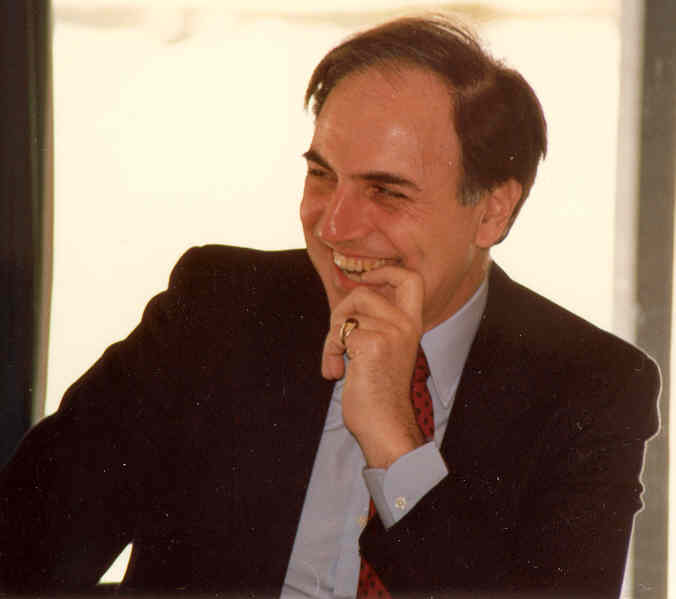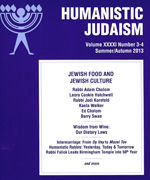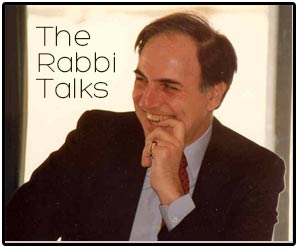Humanistic Judaism, Autumn, Volume 9, No. 3, 1981
Every community needs leaders. If the leaders
must possess expert knowledge they need to be trained leaders.
Humanistic Jews need leaders. They also need
trained leaders.
Up until now we have not dealt directly with
the problem of leaders for Humanistic Judaism. We have simply taken advantage
of Reform rabbis who have been willing to change. We have no training program
for Humanistic Jewish leaders. And, because of that reality, we have no clear
idea of what it means to be a Humanistic rabbi. If the education of our leaders
is in the hands of others, we have to take what we can get.
We have never, as yet, dealt with some
important questions. What does a Humanistic Jewish leader need to know? What
should he be able to do? Is the title rabbi the best designation for
such a leader? If it is, how does the role of the Humanistic rabbi differ from
that of a traditional or liberal rabbi? Above all, how do we provide a
Humanistic Jewish leader with the best possible training for his job?
Before I can answer these questions, I need to
give you some background information about the history of Jewish leadership and
about the problems of using our present ‘negative’ policy of recruitment and
training.
JEWISH LEADERSHIP
In ancient times, when the Jewish people were
a territorial nation, Jewish leaders were secular leaders. Shofets and warrior
kings controlled the nation. Although these rulers claimed the sanction of the
gods, they were not religious professionals. Priests and guild prophets were
kept in subordinate roles.
With the defeat and occupation of Israel by
the Chaldeans, Persians and Greeks the secular rulers were eliminated. The
conquerors elevated religious professionals to national leadership, since they
assumed that they would be the least dangerous and the most compliant. Like the
Irish in the polls, the Jews ended up with theocracy, government by priests. The
Zadokite priests completed the Torah, the first national constitution, and gave
themselves supreme power.
In time a rival group of religious
professionals, the rabbis challenged the priests. Advocates of new ideas about
the Messiah and the resurrection of the dead, they were supported by a powerful
political party called the Pharisees. The rivalry between the priests and the
rabbis was ultimately resolved with the victory of the rabbis. Under the Roman
occupation, the rabbis became the leaders of the Jews. While the rabbinate had
begun as an informal vocation, it became more professional with prestige
academies and official ordination. Ultimately, a second national constitution,
the Mishnah, was published. The Mishnah confirmed the power of the rabbis and established
a permanent theocracy. Rabbinic Judaism became the foundation of the Orthodox
vision of Jewish politics.
The Diaspora reinforced the power of the
rabbis. Deprived of territory and political freedom, the Jews had no trains
leader ship other than the rabbinate. Religious passivity became a safe
alternative to political action. As the custodians of supernatural wisdom the
rabbis governed the Jews in an authoritarian fashion. Only the unavoidable
decentralization of Jewish life and the popular acceptance of their right to
rule kept the rabbinate for being overwhelmingly tyrannical.
When the Enlightenment came to Jewish life in
the nineteenth century, two hostile responses to rabbinic control emerged. The
first response was the secular movement. It value Jewish culture but despised
organized religion and its rabbinic representatives. In a secular age, they
rejected the rabbis, turned to socialism and Zionism, and created a new
informal leadership of intellectuals, culture experts and political activists.
The second response was the Reform movement. Since they were hostile to Jewish
nationalism and defined the Jewish people as a religious denomination, they
were in need of trained religious leaders. But who?
At first, the Reform movement avoided rabbis.
Rabbinic leadership was identified with rabbinic Judaism and the traditions of
Orthodoxy. Early Reform was initiated by laymen. Even the Hamburg Temple, the
‘mother church’ of Reform, used academic “preachers” for their leadership and
recruited no rabbis. But the ‘conversion’ of many orthodox rabbis in the 1840s
to the program of reform made an alternative labor supply available.It also
posed the question of whether the title rabbi, associated with the advocacy of
the Talmudic lifestyle, was appropriate to a Reform leader.
In the end, Reform embraced the “rabbinic,”
howbeit awkwardly. It kept the title but change the role. The judge and
scholar, the expert in Talmudic law was replaced by the secularly educated
preacher and congregational leader. The Protestant model of Northern Europe
became the guide to a new profession with an old name. Although the traditional
rabbis denied legitimacy of Reform ordination, the title gave authority and
religious respectability to the role. In time the designation rabbi made reform
leaders more conservative. They had to justify their use of the label.
Since the first humanistic Jewish leaders were
trained as reform rabbis and were involved with congregational communities,
humanistic rabbis emerged as a coincidence, rather than as a deliberate choice.
While some hostile opponents were always asking “how can you call yourself a
rabbi,” the use of the title seemed convenient and appropriate. Humanistic
leaders were performing the same congregational philosophic and celebration
functions that most rabbis were engaged in. And if Reform, in its rejection of
the traditional rabbinic discipline, had made non-halakhic rabbis possible,
non-theological ones were equally plausible.
At present, professional Humanistic Jewish
leaders are Humanistic rabbis. And they get their training at reform
seminaries.
PROBLEMS
This situation is less than satisfactory.
Reform seminaries are designed to train Reform
rabbis. They view the rabbinate as a religious profession, and not as a
cultural and philosophical one. They overemphasize the theological traditions
of the Jews and underemphasize the secular and profane dimensions. Humanistic
trainees need exposure to humanistic philosophy and to humanistic Jewish
celebration. They need a deep grounding in the Jewish Enlightenment and in the
non-religious intellectual achievement of that experience. While many aspects
of the reform curriculum are relevant to their training, many others are
diverting, parochial, piously inappropriate and compromising of personal
integrity.
Reform seminaries are ambivalent about
training Humanistic rabbis. Some of the faculty at the Hebrew Union College –
Jewish Institute of Religion are sympathetic to a humanistic approach. But
others are overtly hostile. Why should the seminary ordain rabbis who will not
serve the congregations that support it? And why should it train leaders who
will not identify with the public ideology of the Reform movement? Given the
limited number of students who can be accepted into the rabbinic program, why
should precious spaces be given to students who have no commitment to the
Reform enterprise? In an environment of such ambivalence we have no guarantee
that the Reform seminaries will continue to serve our leadership needs.
In fact, students may not presently receive
internship credit for their service to humanistic congregations.
Men and women who are training for the
Humanistic rabbinate need a Humanistic Jewish community to interact with.
Isolation in a Reform seminary is a non-supportive environment. Exposed humanists
are always involved in debate and defense, and not in creative sharing.
Reform rabbis, as part of an establishment
movement, are trained to serve established congregations. They are generally
not accustomed to organizing their own. But Humanistic rabbis presently have to
create the organizations they serve. They need special training in ‘missionary’
work. They need special skills in ‘starting from scratch’. The emotional
standards for recruiting Reform students is different from those appropriate to
Humanistic candidates. Seminary environments of high material expectations and
conventional internships are counter-productive.
Training Reform rabbis means conducting Reform
services. Student interns serve small Reform congregations and have to function
as Reform leaders. How can Humanistic students perform this role with
integrity? If one of the prime ethical values we are seeking to inculcate is
honesty and an absence of hypocrisy, how can we encourage humanistic students
to pretend they believe in prayer. Studying about prayer is one thing. But
doing it in public as a congregational leader is another.
There are many men and women who would make
excellent Humanistic Jewish leaders (if they knew the opportunity were
available) and who would, for reasons of integrity, never set foot in a reform
seminary. Many bright Jews with leadership ability and humanistic commitment
choose careers in political science, law, social work and psychotherapy because
they believe that the rabbinate and seminary training are a violation of their
belief system and a waste of time. If we insist on a Reform education and
provide no alternative program, we will never recruit the best and brightest
for our movement. We will solicit the cautious ones, who will want to hedge their
rabbinic bet with a Reform option.
The most humanistic Jews are not called
humanistic Jews. They designate themselves as secular or cultural
Jews. They have no historic connection with the Reform movement and no great
fondness for the rabbinate. They see themselves as non-religious and are
generally unorganized. If they are
organized they belong to educational and cultural societies with no
professional leadership. Their present malaise partly stems from the absence of
dynamic spokespeople who can give them a presence in the Jewish community and
who are expert enough to invent secular Jewish alternatives. For these cultural
Jews recruiting leaders from a reform seminary would be an absurd act. In fact,
a professional leader who bore a title other than rabbi would be more easily accepted. [Madrikh (leader) is a possible option.]
We presently do not control the training of
our own leaders. We have to settle for what we can get. We are scavengers. We
are “beggers.“. The net result is that we wait around for reform rabbis “to see
the light“ and subject to humanistic candidates to programs we have not
designed. The smallness of our number is no reason for us to consent to this
humiliation. We will never really grow unless we have the self-confidence to
arrange for the training of our own “missionaries.” Aggressive expert
leadership is the key to our expansion. Enemies and in different friends cannot
provide it for us. Nor will our own timidity give us what we need.
PROPOSAL
In the face of these problems we need to take
the following actions.
We need to assume the responsibility for the
training of our own leaders.
We need to draft leadership guidelines,
articulating what we can conceive the leadership role to be and specifying the
requirements we believe to be necessary to qualify as a Humanistic rabbi or as
a professional Humanist Jewish leader. These requirements should include a
training program which concentrates on a humanistic approach to Jewish history
and culture and which features special training in organizing a congregation
and in developing secular forms of Jewish celebration.
We need to provide options for training leaders. We need more than one training program. Being dependent completely on
reform goodwill is too tenuous situation to be tolerable. Candidates for the
Humanistic rabbinate or for Humanistic leadership who desire to attend a Reform
seminary and to receive a Reform ordination (or to attend a Reconstructionist
seminary and to receive a Reconstructionist ordination) should be encouraged to
do so. But an alternative program should be created for candidates who desire a
specifically Humanistic Jewish education. Since the creation of a Humanistic
rabbinic seminary is financially not feasible, a rational alternative is the
use of the graduate program of a major university. An institution like the
University of Chicago, which trains many religious leaders, which features
superb Department of philosophy, history, psychology and Semitic studies, and
which is located in a big city with a big Jewish community is an ideal setting.
The leadership candidate would undertake a doctoral program designed to make
him an expert in both Judaism and humanism. he would also serve as an intern of
the Society for Humanistic Judaism, testing his skills in the practical work of
congregational life. Upon the completion of his doctoral program (an investment
of time equal to that of seminary training) and his internship training, he
would be eligible to be declared a rabbi
and Madrikh (leader) by the Society.
We need to go out and recruit bold and
adventurous young men and women to enter these programs. Humanistic Jewish
congregations will be created by Humanistic rabbis. They will not develop
viability and community presence from only the effort of part-time volunteers.
Reform rabbis who are cautious humanists and who are looking for established
congregations to serve are from our point of view, next to useless. The
successful ones, at this stage of our development, will be the leaders who
enjoyed being pioneers and who enjoy creating their own congregations.
Many people who want to be rabbis and who are
believing humanists will not be successful humanistic rabbis or madrikhim,
because they are too timid. But I am convinced that there are others, who have
never considered the conventional rabbinate for ideal logical and emotional
reasons, who would make superb Humanistic Jewish leaders if they were informed
of the opportunity.
We need to cooperate with Secular Jews and
with other organized humanists to develop our program. Secular Jews need
community and professional leadership. Non-Jewish humanists also need
professional leadership. They can help us develop the humanism side of
leadership training.
OBJECTIONS
One can already imagine some of the objections
to these proposals.
“Training Humanistic rabbis in Reform
seminaries is a good thing. It exposes them to other points of you and rescues
them from professional isolation.“
“No one will accept a rabbinic ordination
issued by the Society for Humanistic Judaism. The idea is pretentious.”
“Why are we bothering to train rabbis to be leaders of secular and
humanistic Jews? If we simply called them madrikhim
we wouldn’t have any problems.”
Answers are necessary.
Exposure to other points of you is important
for rabbis and for all Jews. But it is not the first requirement. Of what value is understanding Reform Judaism
for a Humanistic candidate, if he has no opportunity to fully understand
Humanistic Judaism. Given the limited amount of time he has to master his
profession, and given his need to go out and motivate others, the Humanistic
rabbi needs a good grounding first
in his own chosen approach. Spending his time arguing with Reform students at a
Reform seminary will not rescue him from professional isolation. It will be a
needless indulgence in alienation. Humanistic candidates who want ordination
from an established rabbinic seminary should not be deceived about the nature
of their experience. The reward exacts a high price. And those candidates who
do not want to pay that price should not be rejected. They should have an
option.
As for the credibility of ordination by the
Society, three considerations should be kept in mind. (1) Humanistic rabbis who
choose the optional program will also have the title doctor from a major university. (2) In the organizing phases of a
movement the label of the leader is less important than his personal authority
and charisma. (3) The conventional alternative still exists for those who want it. The other alternative is a
risk-taking venture for the bold. And what we need are bold and creative
leaders.
As for the title rabbi, the use of it is optional. Leaders who want to call
themselves doctor (if they’ve earned it) or madrikh can do so. But, for most Humanistic leaders and laypeople
the word rabbi will continue to be
important. As a label it suggests authority, expert Ness and Judaism and Jewish
leadership. All three conditions are necessary and appropriate for those who
want to guide the community. In a world where rabbi is no longer identified with halakha (orthodox law) and where Judaism is increasingly viewed as
a culture, a secular rabbi is a natural development.
CONCLUSION
The future of Humanistic Judaism will depend
it to a large degree on the quality, self image and training of Humanistic
rabbis. It is time for us to accept this fact and to proceed with integrity.



